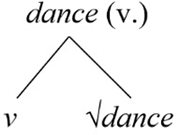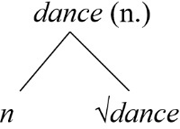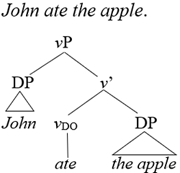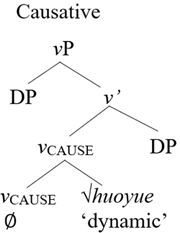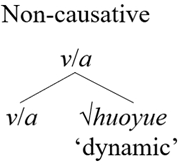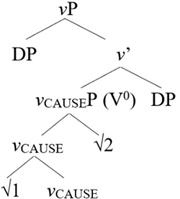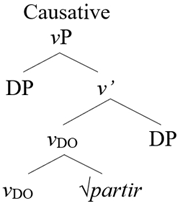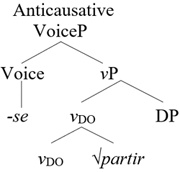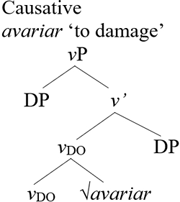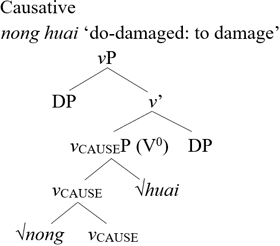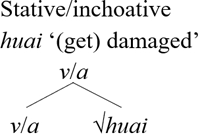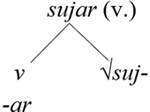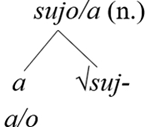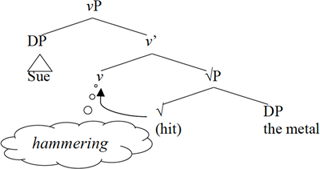1. Introduction
Causatives are constructions that describe a causative situation (Shibatani, 1976). According to Kulikov’s (2001) definition, a causative is a verb or verbal construction meaning ‘cause to V0’ or ‘make V0’, where V0 stands for the embedded base verb (e.g., Peter made John go), or a construction meaning ‘make Q’, where Q is a quality (e.g., John cleaned the table, with the meaning ‘John made the table clean’). Depending on the causer’s role in bringing about the caused event, causatives can also be distinguished as direct (or causer-controlled) and indirect (or causee-controlled) causatives (Kulikov, 2001, p. 892). In the rest of the study, we will use the name causation of an activity to refer to indirect causation with the meaning ‘make V0’ (e.g., ‘make to sit’, ‘make to dance’), and causation of change of state to direct causation with the meaning ‘make Q’ (e.g., ‘make broken’, ‘make dirty’).
Language variation in causatives has been observed in various studies. Typological works (e.g., Comrie, 1976; Comrie, 1989[1981], Chapter 8; Haspelmath, 1993; Kulikov, 2001; Nichols, Peterson, & Barnes, 2004) have found that cross-linguistically, causatives can take the forms of syntactic (or analytic) causatives, morphological causatives, and lexical causatives, and that languages vary on what forms are employed to express a particular type of causative meanings, what verbs can alternate, and whether a causative marker, an anticausative marker, or no marker is involved.
This study attempts to contribute to the study of language variation on causative formation by comparing European Portuguese (Portuguese, hereafter) and Mandarin Chinese (Chinese, hereafter). We will first discuss syntactic causatives, morphological causatives, and lexical causatives in these two languages and then focus on the causation of change of state – this is where the two languages show significant variation.
2. Syntactic, morphological, and lexical causatives
2.1. Syntactic causatives
Syntactic causatives, also called analytic causatives or periphrastic causatives, involve a causative marker which is a free form, typically a verb with the meaning ‘cause’, ‘make’, ‘let’, ‘give’, etc. (Kulikov, 2001). Portuguese syntactic causatives are formed with causative verbs (Vcaus) such as fazer ‘to do, to make’, mandar ‘to order, to make’, and deixar ‘to let, to make’. It has been observed that these causative verbs can produce causatives with four different forms: Vcaus + finite (1a), Vcaus + inflected infinite (1b), ECM/Raising-to-object type (1c), and fazer-Inf (1d) (see Barbosa & Raposo, 2013; Gonçalves, 1999a; Gonçalves, 1999b; Raposo, 1981; Santos, Gonçalves, & Hyams, 2016):
- (1)
- ‘He made the children leave.’1
- (a)
- Vcaus + finite
- Ele
- he
- mandou
- made
- que
- comp
- os
- the
- meninos
- children
- saíssem.
- leave [imperf.subj.3pl]
- b.
- Vcaus + inflected infinite
- Ele
- he
- mandou
- made
- os
- the
- meninos
- children
- saírem.
- leave [infl. inf.3pl]
- (c)
- Vcaus + non-inflected infinite (ECM/Raising-to-object)
- Ele
- he
- mandou
- made
- os
- the
- meninos
- children
- sair.
- leave [inf]
- (d)
- Vcaus + non-inflected infinitive (fazer-Inf)
- Ele
- he
- mandou
- made
- sair
- leave [inf]
- os
- the
- meninos.
- children
These causative verbs are selective in terms of the caused event. For example, a caused unaccusative may occur with fazer but not mandar (2). Nevertheless, the sentence with mandar in (2b) may be acceptable in contexts such as children’s tale where the stones are personified and can be ordered to fall.
- (2)
- ‘John made the stones fall.’
- (a)
- O
- the
- João
- John
- fez
- made
- cair
- fall
- as
- the
- pedras.
- stones
- (b)
- *O
- the
- João
- John
- mandou
- made
- cair
- fall
- as
- the
- pedras.
- stones
Another group of instances that are included in our discussion is the simple resultatives (terminology from Mateu, 2012) formed by a light verb (e.g., fazer ‘to do, to make’, pôr ‘to put’ or tornar ‘to turn’) and an adjective/participle, as exemplified in (3). Contrasting with (1) and (2), which denote the causation of an action or activity, the simple resultatives express the causation of a change of state.
- (3)
- (a)
- O
- the
- cozinheiro
- cook
- fez
- made
- o
- the
- guisado
- stew
- salgado.
- salty
- ‘The cook made the stew salty.
- (b)
- A
- the
- chuva
- rain
- pôs
- put
- o
- the
- pavimento
- road
- escorregadio.
- slippery
- ‘The rain made the road slippery.’
- (c)
- O
- the
- sucesso
- success
- empresarial
- in.business
- tornou
- turned
- esse
- that
- economista
- economist
- apreciado.
- valued
- ‘The business success made that economist valued.’ (Duarte & Oliveira, 2010)
In Chinese, syntactic causatives generally are formed with the causative verbs 使shi, 让rang, and 令ling, among which 使shi has the generic causative meaning ‘to make’, 让rang has the meaning ‘to let, to make’ (similar to Portuguese deixar), and 令ling has the meaning ‘to order, to make’ (similar to Portuguese mandar). The Chinese syntactic causatives surface as NP1 + Vcaus + NP2 + VP, as illustrated in (4):
- (4)
- 这
- Zhe
- this
- 件
- jian
- CLF2
- 事
- shi
- thing
- 让/令/使
- rang/ling/shi
- make
- 孩子
- haizi
- child
- 感到
- gandao
- feel
- 非常
- feichang
- very
- 开心。
- kaixin.
- happy
- ‘This thing makes the child feel very happy.’
Besides 让rang, 令 ling and 使shi, the causative verbs occurring in Chinese syntactic causatives may also be 叫jiao ‘to call, to make’ or 害hai ‘to harm, to make’. The choice depends on the speaker’s presupposition, the intended style of speech, and the nature of the caused event (Huang, 1974). For instance, 使shi tends to causativize a psychological state (4), but not a physical action, as shown in (5).
- (5)
- 爸爸
- Baba
- dad
- 让/*使
- rang/*shi
- make
- 孩子们
- haizimen
- children
- 出去
- chuqu
- leave
- 了。
- le.
- ASP
- ‘Dad made the children leave.’
The causative verbs 使shi /让rang /令ling may also embed an AP, expressing the causation of change of state, surfacing as NP1 + Vcaus + NP2 + AP, as shown in (6). However, when 使shi serves as the causative verb, this sentence sounds a bit less natural than that with 让rang or 令ling.
- (6)
- 这
- Zhe
- this
- 件
- jian
- CLF
- 事
- shi
- thing
- 让/令/使
- rang/ling/shi
- make
- 孩子
- haizi
- child
- 非常
- feichang
- very
- 开心。
- kaixing.
- happy
- ‘This thing makes the child very happy.’
From the observations above, we can see that both Portuguese and Chinese exhibit causative verbs, which can create causative constructions productively. Semantic variations are observed among the causative verbs, which are language-specific.
2.2. Morphological causatives
In morphological causatives, causativity is encoded in a causative morpheme instead of a verb. Productive morphological causatives are attested in various languages, such as Turkish, Sanskrit, Ewenki, Georgian, Hindi, Japanese, and Finnish (see Comrie, 1976; Falk, 1991; Montrul, 2001; Pylkkänen, 2002; a.o.). Consider the examples in (7):
- (7)
- (a)
- Japanese (Pylkkänen, 2002)
- John-ga
- John-NOM
- kodomo-o
- child-ACC
- nak-asi-ta.
- cry-CAUSE-PAST
- ‘John made the child cry.’
- (b)
- Turkish (Montrul, 2001)
- Düşman
- enemy
- gemi-yi
- ship-ACC
- bat-ir-mış.
- sink-CAUSE-PAST
- ‘The enemy sank the ship/made the ship sink.’
As Kulikov (2001) pointed out, Romance languages generally lack productive morphological causatives. Some affixes can form verbs with causative meanings in Portuguese, such as -ificar and -ear, as in puro ‘pure’ – purificar ‘to purify’ and branco ‘white’ – branquear ‘to whiten’, where the verbs denote causation of a change of state. However, no causative morpheme can productively derive causatives by attaching to a base root in Portuguese, contrasting with languages such as Japanese and Turkish. Although many Portuguese verbs with -ar may involve causative meanings, such as those in (8), Matos (1999) points out that not all verbs with -ar involve causativity (9) and suggests that it is not the suffix but the semantic properties of the base roots that drive the causative interpretation in (8).
- (8)
- (a)
- [doce]ADJ ‘sweet’ – [adoçar]V ‘to sweeten’
- (b)
- [sujo]ADJ ‘dirty’ – [sujar]V ‘to make dirty’
- (9)
- (a)
- [buzina]N ‘horn’ – [buzinar]V ‘to honk’ (*‘to make (into) horn’)
- (b)
- [almoço]N ‘lunch’ – [almoçar]V ‘to have lunch’ (*to make (into) lunch’)
Morphological causatives existed in Old Chinese but underwent a fade-away during language development. In Old Chinese, causative meanings could be expressed through phonological or morphological changes such as tonal change and affixation (see Shi, 2002; Xu, 2006; Mei, 2012). For example, in (10), the prefix *s- alters the verb’s meaning from ‘to eat’ to ‘to feed’, bringing about the causative interpretation.
- (10)
- The prefix *s- (Xu, 2006, p. 114)
- (a)
- 食*bmlik > zyik > shí ‘to eat’3
- (b)
- 食*bsliks > ziH > sì ‘to feed’
This morphological/phonological mechanism to create causatives faded away gradually in the history of Chinese, and only relics can be found in Modern Chinese. The morpheme -化hua might be the only existing morpheme with causative function in Modern Chinese, similar to the Portuguese morpheme -ificar (e.g., puro ‘pure’ – purificar ‘to purify’). As illustrated in (11), when -化hua attaches to the base root 美mei ‘beautiful, beauty’, the causative meaning ‘to beautify’ is produced. Other combinations include 绿化lü-hua ‘green-HUA: to make green’, 现代化xiandai-hua ‘modern-HUA: to modernize’ and 国际化guoji-hua ‘international-HUA: to internationalize’. In recent years, the causative formation with -化hua has become highly productive. One can literally attach -化hua to any nominal or adjective to produce causative meanings.
- (11)
- (a)
- 美 mei, a. ‘beautiful’; n. ‘beauty’
- (b)
- 美化 mei-hua, v. ‘to beautify’
- (c)
- 我们
- Women
- we
- 要
- yao
- should
- 美化
- meihua
- beautify
- 我们的
- womende
- our
- 生活
- shenghuo
- life
- 环境。
- huanjing.
- environment
- ‘We should make our living environment beautiful./We should beautify our living environment.’
Based on the observations above, we can see that both Portuguese and Chinese exhibit some morphemes with causative meanings. However, it is worth noting that these morphemes can only apply to a non-agentive root to express causation of change of state (e.g., purificar ‘to purify’ and 美化mei-hua ‘to beautify’). They can never express the causation of an activity. That contrasts with languages such as Finnish and Turkish, where causation of an agentive event can also be expressed through morphological means (see Comrie, 1976; Montrul, 2001; Pylkkänen, 2002; a.o.).
Nevertheless, verbs that intrinsically express the causation of change of state seem to be more available in Portuguese than in Chinese. Many Portuguese verbs that contain a morphological constituent plus a state base, such as sujar ‘to stain’ and limpar ‘to clean’, do not have Chinese equivalents in simplex verb forms. For example, the Chinese counterpart of sujar ‘to stain’ takes a complex form, as shown in (12b, c), where the verbal component that denotes the causing activity (V1) precedes the one encoding the result (V2). Since the two Vs are in adjacency, we will call them Causative Resultative V-Vs (CR V-Vs) throughout this study.4 In the literature, other names used to refer to this construction include “resultative V-V compounds” (e.g., Li, 1990), “resultative compounds” (e.g., Huang, 1984; Cheng & Huang, 1994; Basciano, 2010), and “resultative verb compounds” (e.g., Thompson, 1973; Lu, 1977; Gao, 1997; Li, 2007).
- (12)
- (a)
- 脏zang a. dirty
- (b)
- 男孩
- Nanhai
- boy
- 弄
- nong
- make
- 脏
- zang
- dirty
- 桌子
- zhuozi
- table
- 了。
- le.
- ASP
- ‘The boy stained the table./The boy made the table dirty.’
- (c)
- 男孩
- Nanhai
- boy
- 画
- hua
- paint
- 脏
- zang
- dirty
- 桌子
- zhuozi
- table
- 了。
- le.
- ASP
- ‘The boy made the table dirty by painting (on it).’
Note that we do not categorize CR V-Vs as syntactic causatives (see Section 2.1) for a few reasons. First of all, although the V1 弄nong in (12b) denotes a generic meaning of ‘to do, to make’, it is not an alternative to the causative verbs found in the syntactic causatives presented in Section 2.1. In addition, the V1 in CR V-Vs may be a verb that refers to a concrete and specific activity, as in (12c), and there can be a non-exhaustive list of possible V1s. In other words, the causative meanings in CR V-Vs are not produced by any causative verb (Vcaus), contrasting to the syntactic causatives. When 弄nong ‘do, make’ serves as V1 in CR V-Vs, as in (12b), the causing activity is simply understood as “doing something”.5 A further difference is that CR V-Vs exhibit compound features and show tight integrity. A more detailed description of CR V-Vs will be provided in Section 2.4.
The Portuguese verb limpar ‘to clean’ also corresponds to Chinese expressions in the CR V-V form, where V1 may have a generic (13b) or specific (13c) meaning.
- (13)
- (a)
- O
- the
- João
- John
- limpou
- cleaned
- a
- the
- roupa.
- clothes
- ‘John cleaned the clothes.’
- (b)
- 他
- Ta
- he
- 弄
- nong
- make
- 干净
- ganjing
- clean
- 衣服
- yifu
- clothes
- 了。
- le.
- ASP
- ‘He made the clothes clean./He cleaned the clothes.’
- (c)
- 他
- Ta
- he
- 洗
- xi
- wash
- 干净
- ganjing
- clean
- 衣服
- yifu
- clothes
- 了。
- le.
- ASP
- ‘He cleaned the clothes by washing (them).’
One may argue that the meaning ‘to clean’ can be expressed by a single verb in Chinese, namely 打扫dasao. However, note that this verb only denotes the activity of ‘doing cleaning’ without implying a result. For this reason, the semantic meaning of (14b) is not equivalent to the Portuguese sentence with limpar ‘to clean’ in (14a). To include the result meaning that ‘the room became clean’, a CR V-V form should be employed with the occurrence of an overt result component, as in (14c).
- (14)
- (a)
- Ele
- he
- limpou
- cleaned
- o
- the
- quarto.
- room
- ‘He cleaned the room.’
- (b)
- 他
- Ta
- he
- 打扫
- dasao
- do.cleaning
- 了
- le
- ASP
- 房间。
- fangjian.
- room
- ‘He did some cleaning in the room.’
- (c)
- 他
- Ta
- he
- 打扫
- dasao
- do.cleaning
- 干净
- ganjing
- clean
- 了
- le
- ASP
- 房间。
- fangjian.
- room
- ‘He did some cleaning in the room, and the room became clean (i.e., he cleaned the room).’
2.3. Lexical causatives
In contrast to morphological causatives, lexical causatives lack any regular and productive causative marker (Kulikov, 2001), such as brown, thin, smooth, dry, and narrow when used as verbs.
Lexical causatives may be subdivided into a suppletive type and a labile type (see Comrie, 1989; Kulikov, 2001): the suppletive subtype consists of verbs with causative meanings and are in a suppletive relation with their non-causative counterparts, e.g., kill – die; the labile subtype includes the lexical causatives which are not formally distinguishable from their non-causative counterparts, including but not limited to the so-called alternating verbs (i.e., verbs that allow causative/transitive alternation) such as break and open.
Both Portuguese and Chinese have suppletive verb pairs. They come to have a similar group of meanings (e.g., ‘kill’ – ‘die’, ‘teach’ – ‘learn’) for metalinguistic reasons (since people’s conceptualization and experience are generally the same). However, semantic differences are observed. Taking the pair ‘kill’ – ‘die’ as an example, the meaning of the Portuguese verb matar ‘to kill’ assumes a completed caused event denoted by morrer ‘to die’. As shown in (15a), the refutation is not allowed because it contradicts the first part of the sentence (i.e., ‘the girl was killed and thus died’). In contrast, the Chinese verb 杀sha ‘to kill’ does not necessarily assume the completion of 死si ‘to die’; therefore, refutation is possible (15b) (see Tai, 1984; Sybesma, 1997; a. o.).6 The Chinese equivalence of Portuguese matar ‘to kill’ should take a complex form, namely a CR V-V, as illustrated in (15c), where V2 explicitly expresses the result. As expected, this sentence does not allow refutation.
- (15)
- (a)
- Ele
- he
- matou
- killed
- a
- the
- menina,
- girl
- (# mas
- (# but
- a
- the
- menina
- girl
- não
- not
- morreu).
- died)
- ‘He killed that girl, (# but the girl did not die).’
- (b)
- 他
- Ta
- he
- 杀
- sha
- kill
- 那
- na
- that
- 个
- ge
- CLF
- 女孩
- nühai
- girl
- 了,
- le,
- ASP
- (但是
- (danshi
- (but
- 女孩
- nühai
- girl
- 没有
- meiyou
- not
- 死)。
- si).
- die)
- ‘He (went to) kill that girl, but the girl did not die.’
- (c)
- 他
- Ta
- he
- 杀
- sha
- kill
- 死
- si
- die
- 那
- na
- that
- 个
- ge
- CLF
- 女孩
- nühai
- girl
- 了,
- le,
- ASP
- (# 但是
- (# danshi
- (# but
- 女孩
- nühai
- girl
- 没有
- meiyou
- not
- 死)。
- si.
- die)
- ‘He killed that girl to death, (# but the girl did not die).’
Verbs that allow causative alternation are attested in Portuguese, but it is quite common that the unaccusative clitic -se is used in the intransitive structure, as illustrated in (16).
- (16)
- (a)
- O
- the
- João
- John
- partiu
- broke
- a
- the
- garrafa.
- bottle
- ‘John broke the bottle.’
- (b)
- ??/*
- A
- the
- garrafa
- bottle
- partiu.
- broke
- ‘The bottle broke.’
- (c)
- A
- the
- garrafa
- bottle
- partiu-se.
- broke-CL7
- ‘The bottle broke.’
However, there also exist verbs that do not require or disallow the occurrence of the clitic -se in the intransitive counterpart, as illustrated in (17)–(18) (see Matos, 1999).
- (17)
- (a)
- O
- the
- calor
- heat
- derreteu
- melted
- a
- the
- neve.
- snow
- ‘The heat melted the snow.’
- (b)
- A
- the
- neve
- snow
- derreteu/derreteu-se.
- melted/melted-CL
- ‘The snow melted.’
- (18)
- (a)
- A
- the
- Ana
- Ana
- ferveu
- boiled
- o
- the
- leite.
- milk
- ‘Ana boiled the milk.’
- (b)
- O
- the
- leite
- milk
- ferveu/*ferveu-se.
- boiled/*boiled-CL.
- ‘The milked boiled.’
The clitic -se here is usually treated as an anticausative marker, which permits an anticausative process, deriving intransitive configurations from a transitive verb. With regard to (17) and (18), where the occurrence of this clitic is not required or even disallowed, we follow Matos (1999) and assume that the anticausative morpheme is not phonetically realized, being null. In the case of non-occurrence of any anticausative marker, they can be considered labile lexical causatives (under the assumption that the notion of labile lexical causatives refers to verbs’ superficial forms).
The labile lexical causatives were very common in Old Chinese but are much less common in Modern Chinese. In Old Chinese, they could be formed from adjectives, nouns/nominals, or verbs – they are also called “zero causatives” since no overt causative marker is involved. As illustrated in (19), 树shu, a noun with the meaning of ‘tree’, turns to function as a transitive verb when preceding 之zhi ‘it’, producing the causative meaning ‘to make it have trees, to plant’. In (20), 厚hou is an adjective with the meaning ‘thick’; when preceding the NP 墙垣qiangyuan ‘wall’, it comes to have the causative meaning ‘to make the wall thick, to thicken’. Similarly, in (21), the intransitive verbs 进jin ‘go forward’ and 退tui ‘withdraw’ obtain causativity when preceding 之zhi ‘him’, producing the meanings ‘make him go forward’ and ‘make him withdraw’. The three examples are found in Xu (2006, p. 118), Shen and Huang (2017), and Xu (1998), respectively.
- (19)
- Lexical causative formed from a noun
- (a)
- 树shu, ‘tree’
- (b)
- 树
- Shu
- tree
- 之
- zhi
- it
- 以
- yi
- with
- 桑
- sang
- mulberry
- (Mencius, 4th Century BC)8
- ‘Plant it with mulberry’
- (20)
- Lexical causative formed from an adjective
- (a)
- 厚hou, ‘thick’
- (b)
- 厚
- Hou
- thick
- 其
- qi
- the
- 墙垣
- qiangyuan
- wall
- (Zuozhuan, 4th Century BC)9
- ‘Make the wall thick.’
- (21)
- Lexical causative formed from an intransitive verb
- (a)
- 进jin, ‘go forward, advance’; 退tui, ‘withdraw, go back’
- (b)
- … 故
- … gu
- so
- 进
- jin
- go-forward
- 之 ; …
- zhi; …
- him
- 故
- gu
- so
- 退
- tui
- withdraw
- 之。
- zhi.
- him
- (Analects, around 400–200 BC)10
- ‘… so (I) made him go forward; …so (I) made him withdraw.’
It has been observed that Chinese shifted from a fairly synthetic language to an analytic language (Huang, 2006, p. 25), and the causatives also underwent this shift: the morphological causatives and labile lexical causatives gradually decreased (see Xu, 2006; Shen & Huang, 2017). However, some instances of zero causatives can still be found in Modern Chinese, as shown in (22).
- (22)
- (a)
- 科技
- Keji
- technology
- 繁荣
- fanrong
- prosper
- 了
- le
- ASP
- 市场
- shichang
- market
- 经济。
- jingji.
- economy
- ‘Technology made the market economy prosper.’
- (b)
- 游戏
- Youxi
- game
- 可以
- keyi
- can
- 活跃
- huoyue
- dynamic
- 气氛。
- qifen.
- atmosphere
- ‘Games can make the atmosphere dynamic.’
In Modern Chinese, few simplex verbs allow causative alternation. The verbs 开kai ‘open’ (23) and 关guan ‘close, turn off’ (24) are among the very few ones.
- (23)
- (a)
- 老师
- Laoshi
- teacher
- 开
- kai
- open
- 了
- le
- ASP
- 门。
- men.
- door
- ‘The teacher opened the door.’
- (b)
- 门
- Men
- door
- 开
- kai
- open
- 了。
- le.
- ASP
- ‘The door opened.’
- (24)
- (a)
- 他
- Ta
- he
- 关
- guan
- close
- 了
- le
- ASP
- 门。
- men.
- door
- ‘He closed the door.’
- (b)
- 门
- Men
- door
- 关
- guan
- close
- 了。
- le.
- ASP
- ‘The door closed.’
Consequently, the transitive and intransitive use of Portuguese alternating verbs may correspond to different verbal expressions in Chinese. For example, the Portuguese verb partir ‘to break’ can be used transitively and intransitively, as shown in (16a, c) above; in contrast, the Chinese verb 碎sui ‘to break’ is pure intransitive (25a), as shown by the ungrammaticality of the attempted transitive use in (25b). In this case, CR V-Vs should be employed to express causative meanings, with a verb denoting the causing activity to precede 碎sui ‘break’, as shown in (25c, d).
- (25)
- (a)
- 花瓶
- Huaping
- vase
- 碎
- sui
- break
- 了。
- le.
- ASP
- ‘The vase broke.’
- (b)
- *我
- *Wo
- I
- 碎
- sui
- break
- 了
- le
- ASP
- 花瓶。
- huaping.
- vase
- ‘I broke the vase.’
- (C)
- 我
- Wo
- I
- 弄
- nong
- make
- 碎
- sui
- break
- 了
- le
- ASP
- 花瓶。
- huaping.
- vase
- ‘I made the vase break./I broke the vase.’
- (d)
- 我
- Wo
- I
- 踢
- ti
- kick
- 碎
- sui
- break
- 了
- le
- ASP
- 花瓶。
- huaping.
- vase
- ‘I broke the vase by kicking (it).’
2.4. Compound causatives
In the previous sections, it has been observed that quite many Portuguese verbs that intrinsically denote causative and resultative meanings, either as morphological or lexical causatives, correspond to a compound type of causatives in Chinese, namely the CR V-Vs. We will dedicate this section to a brief presentation of this Chinese construction.
The Chinese CR V-V has attracted a lot of attention in the past decades due to its complex and interesting properties (see Thompson, 1973; Lu, 1977; Huang, 1984, 1992; Li, 1990, 1995; Cheng & Huang, 1994; Gao, 1997; Sybesma, 1999; Lin, 2004; Her, 2007; Li, 2007; Basciano, 2010; Fan, 2013; Liu, 2019). First, they show verb-like properties and can further undergo passivization, as shown in (26a), which presents a passivized form of (25d). Each CR V-V is read as one intonational unit, and the two Vs cannot be intervened by an NP, an adverbial modifier or an aspect marker (26b). Despite these compound properties, CR V-Vs also show syntactic features and are highly productive. For example, there is a non-exhaustive list of possible V1s to form CR V-Vs with 碎sui ‘break’ (26c).
- (26)
- (a)
- 花瓶
- Huaping
- vase
- 被
- bei
- PASS
- 我
- wo
- I
- 踢
- ti
- kick
- 碎
- sui
- break
- 了。
- le.
- ASP
- ‘The vase got broken by me kicking (it).’
- (b)
- *我
- *Wo
- I
- 踢
- ti
- kick
- 了
- le
- ASP
- 碎
- sui
- break
- 花瓶。
- huaping.
- vase
- ‘I broke the vase by kicking (it).’
- (c)
- 打da/踢ti/碰peng/弄nong/挤ji/压ya/扔reng/…+碎sui
- hit/kick/touch/make/squeeze/press/throw…+break
Semantically, CR V-Vs denote the meaning of a change of state, and thus the component at the V2 position is subject to semantic constraints. For instance, unergative verbs cannot occur at the V2 position. As shown in (27), while the verb 跑pao has both an unergative (i.e., ‘to run’) and an unaccusative use (i.e., ‘to escape’), only the unaccusative one is acceptable at the V2 position.
- (27)
- 他
- Ta
- he
- 弄
- nong
- make
- 跑
- pao
- *run/escape
- 了
- le
- ASP
- 犯人。
- fanren.
- prisoner
- ‘He made the prisoner *run/escape.’
Moreover, some CR V-Vs may show semantic ambiguity, allowing two or more different readings (28).
- (28)
- 女孩
- Nühai
- girl
- 追
- zhui
- chase
- 累
- lei
- tired
- 他
- ta
- he
- 了。
- le.
- ASP
- (a) ‘The girl chased him and got tired.’
- (b) ‘The girl chased him, and he got tired.’
- (c) ‘He chased the girl and got tired.’
From a diachronic perspective, it has been claimed that CR V-Vs only occurred at a later stage of Chinese language development, accompanied by the gradual decline of morphological and zero causatives (see Shi, 2002; Xu, 2006; a. o.). Various authors (e.g., Shi, 2002; Xu, 2006) suggest that the rise of CR V-Vs was driven by a disyllabification tendency of words that occurred in the development of Chinese. As reviewed by Shi (2002, pp. 71–72), before 200 BC, Chinese words were primarily monosyllabic, and disyllabic words represented only approximately 20% of the Chinese lexicon, but in Modern Chinese, more than 80% of the words are disyllabic. In Old Chinese, verbs were mainly monosyllabic, and some could intrinsically express a caused-result event. Later, due to the disyllabification tendency, two monosyllabic verbs adjoined each other to form a unit to express caused-result meanings, resulting in a V-V surface, with V1 overtly denoting the causing event and V2 the result.
Due to the complexity of CR V-V’s properties, authors hold different opinions regarding the nature of this construction (for example, whether they are formed in the lexicon or syntax), and various proposals can be found in the literature. We claim that CR V-Vs are syntactically derived compounds, whose syntactic structures will be presented in Section 3 of this study.
2.5. Other related phenomena
There is a group of transitive verbs in Portuguese that can derive participles (or deverbal adjectives), such as avariar ‘to damage’ – avariado ‘damaged’, cansar ‘to make tired’ – cansado ‘tired’, and inclinar ‘to incline’ – inclinado ‘inclined’ (see Duarte & Oliveira, 2010 for discussions on Portuguese participles). These pairs can be considered analogous to the causative-anticausative pairs presented in Section 2.3 since the causative member is in a basic form, and the non-causative counterpart (e.g., the participle) is further derived. Interestingly, these formally simplex but semantically complex (i.e., involving causative and resultative meanings) verbs may not have Chinese counterparts in simplex forms. For example, the meaning ‘to damage’ (denoted by the verb avariar in Portuguese) is expressed by CR V-Vs in Chinese, as in (29b), where the cause-denoting V1 precedes the result-denoting V2 坏huai ‘damaged’.
- (29)
- (a)
- 坏huai ‘damaged’
- (b)
- 弄坏nong-huai ‘make-damaged: to damage’
- 损坏sun-huai ‘harm-damaged: to damage’
- 破坏po-huai ‘break-damaged: to damage’
In (29b), the first expression 弄坏nong-huai ‘make-damaged: to damage’ is considered a CR V-V in our definition. The latter two have lexicalized and are expected to be listed in dictionaries. Regardless of the lexicalization process, all these three are analyzable verb compounds, with V1 denoting the causing eventuality and V2 the result. There is a non-exhaustive list of possible combinations of V1 + huai ‘damaged’ to produce the meaning of ‘to make something damaged through the activity denoted by V1’.
Furthermore, some of the Portuguese verbs that intrinsically involve caused-result meanings may correspond to syntactic causatives in Chinese. For example, no Chinese verb corresponds to the Portuguese verb interessar ‘to interest’, which involves a causative meaning (‘to make someone interested’) and can derive a participle (interessado ‘interested’). As illustrated in (30), the Chinese counterpart employs syntactic means (via the Vcaus 让rang ‘to let, to make’) to causativize the result-denoting expression 感兴趣ganxingqu ‘interested’.
- (30)
- (a)
- O
- the
- trabalho
- study
- interessa-lhe
- interest-him
- muito.
- much
- ‘The study interests him a lot.’
- (b)
- 这
- Zhe
- this
- 个
- ge
- CLF
- 研究
- yanjiu
- study
- 让
- rang
- make
- 他
- ta
- him
- 很
- hen
- very
- 感兴趣。
- ganxingqu.
- interested
- ‘This study makes him very interested./This study interests him a lot.’
2.6. Summary of comparison
Based on the observations in the previous sections, the causative forms that are applied to produce causation of activity and causation of change of state in Portuguese and Chinese are summarized in Table 1.
Comparison based on the caused eventuality.
| Causation of an activity | Causation of change of state | |||
| Portuguese | Chinese | Portuguese | Chinese | |
| Syntactic causatives | √ | √ | √ | √ |
| Single verbs which intrinsically contain caused-result meanings | √ | some | ||
| Compound causatives | √ | |||
As shown in Table 1, both Portuguese and Chinese exhibit syntactic means to express the causation of an activity. However, these two languages exhibit quite a significant variation in the causation of change of state. With syntactic means available in both languages, Portuguese exhibits plenty of verbs (including morphological and lexical causatives) that intrinsically involve caused-result meanings, whereas the Chinese correspondents may appear in complex forms, such as compound causatives. In the next section, we will focus on the two languages’ differences in expressing the causation of change of state and attempt to provide an explanation.
3. Causation of change of state
3.1. Theoretical assumptions
In this study, I assume the general idea of Distributed Morphology (Halle & Marantz, 1993, 1994; Marantz, 1997) that the syntax is the only generative system responsible for both word structure and phrase structure and that the “Narrow Lexicon” consists of “lexical roots” and “bundles of grammatical features” (functional elements): the roots are acategorial, and their function is to provide encyclopedic meanings; they can only get categorized and interpreted by merging with a categorizing functional head little x, such as v, n or a, which can categorize a lexical root as a verb, noun or adjective respectively, as illustrated in (31).
- (31)
- (a)
- (b)
In particular, the core structure of a verb phrase contains a little v head and a root, as illustrated in (31a): the little v semantically introduces an eventuality, and the root modifies this event by contributing semantic content. According to Folli and Harley (2005, 2007), the different nature of events (e.g., causative, unaccusative, stative, unergative) is not determined by the semantic information contained in the lexical roots but rather by the different “flavors” of v heads that contain specific event-semantic content, such as vCAUSE, vBECOME, vDO. In particular, vDO is an agentive v, which requires an animate Agent subject; vDO can take a straightforward Incremental Theme as its Complement and is a true verb of creation, as exemplified in (32a). In contrast, vCAUSE is a causative v, which only requires that the subject be a possible Cause; vCAUSE takes a state as its Complement, creating a resultative structure essentially, as in (32b).
- (32)
- (a)
- (b)
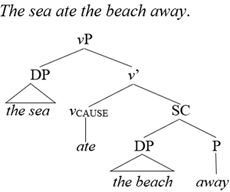
- (Adapted from Folli & Harley, 2005)
3.2. Semantics of verb roots
As presented in Section 2, Portuguese exhibits many verbs that express complex meanings, involving causation and result, such as matar ‘to kill’, sujar ‘to stain’, and avariar ‘to damage’. Their Chinese correspondents often take complex forms, usually CR V-Vs, and sometimes syntactic causatives. We posit that the semantic meanings of roots play a role here.
Chinese simplex verbs generally tend to express simplex meanings, either a pure activity or a (change of) state, but rarely both (see Tai, 1984; Sybesma, 1997; a. o.).11 We have already shown that the Chinese verb 杀sha ‘to kill’ only denotes the action of ‘killing’ without implying a result (15b); 碎sui ‘to break’ only denotes the inchoative meaning ‘become broken’ without involving causation (25a, b). In Chinese, we can find pairs of verbs showing a division of labor, with one member denoting a pure activity and the other the corresponding result (or change of state). One example is ‘to boil’. The corresponding verbs in English (boil) and Portuguese (ferver ‘to boil’) can denote both the causing activity (e.g., ‘someone boils water’) and the caused result (e.g., ‘the water is boiling/boiled’). However, in Chinese, the causative and resultative meanings are expressed separately by a pair of verbs, as illustrated in (33a). The meaning ‘he boiled the water’ with the result ‘the water boiled’ implied should be expressed by a CR V-V in Chinese, with the activity-denoting member preceding the result-denoting member, as in (33b).12
- (33)
- (a)
- 煮zhu ‘to boil’ (the activity)
- 沸fei ‘to boil’ (the result)
- (b)
- 他
- Ta
- he
- 煮
- zhu
- boil(activity)
- 沸
- fei
- boil(result)
- 了
- le
- ASP
- 水。
- shui.
- water
- ‘He boiled water (and made it boiled).’
Only a few Chinese verbs may express both an activity and a result. They are typically the verbs that allow causative alternation (see Section 2.3), such as 开kai ‘to open’. They not only can convey the meaning of causation of change of state but may also occur in CR V-Vs as one component. Since they can express both an activity and a result, the same verb may simultaneously serve as V1 and V2, showing the division of labor. In (34), 开kai in the V1 position denotes the pure activity of ‘to open the door’, and the one in the V2 position indicates the result ‘the door opened.’
- (34)
- 孩子
- haizi
- child
- 开
- kai
- open(activity)
- 开
- kai
- open(result)
- 门
- men
- door
- 了。13
- le.
- ASP
- ‘The child opened the door (and made it open).’
I attribute the contrast to the roots’ different semantics in these two languages. In general, Portuguese roots may be intrinsically complex in their semantics, involving both causative and resultative meanings. In contrast, Chinese verb roots tend to express only an activity or a (change of) state. Under the assumption that the semantic meaning of a root determines what head(s) it can be merged with, we can infer that the semantic differences between Portuguese and Chinese roots may impact the possible structures that the roots can fit in. For instance, the encyclopedic meaning of the Portuguese root √partir ‘break’ is agentive/causative, and therefore the root can merge with vDO. Contrastingly, the meaning of the Chinese root √sui ‘break, broken’ is inchoative or stative, and therefore, this root can only be compatible with vBECOME, vBE, or a but not vDO.14 As shown in (35a), by merging with vDO, the Portuguese root √partir ‘break’ is turned into a verb with causative meanings (with complex event structure). However, such a structure is incompatible with the Chinese root √sui ‘break’. Instead, this Chinese root can merge with vBECOME to express a change of state event without causation (with a simplex event structure). We would like to highlight that the Portuguese root √partir cannot express stative meanings intrinsically, as shown by the unacceptable attempted adjectives formed with √partir merged with an a head, *parto/a ‘broken’. The stative counterpart requires further derivation departing from [vDO √partir], resulting as a participle (partido/a ‘broken’), which will be discussed later in Section 3.3.2.
Moreover, as shown in (35b), although the Portuguese root √matar ‘kill’ and the Chinese root √sha ‘kill’ are both intrinsically agentive and can merge with vDO, the generated verbs express different semantic meanings (with different event structures). It is because, after the merge of a root and a head, the expressed semantic meanings are produced by the joint force of the encyclopedic meaning of the root and the eventuality introduced by the head. In other words, merging with the same head does not guarantee a similar event structure – the meaning of the root also plays an important role. If a root is semantically complex intrinsically, it comes to express a complex event when turned into a verb by merging with vDO – this is the case with Portuguese matar ‘kill’, which contains both causative and resultative meanings. Contrastingly, the Chinese root √sha ‘kill’ denotes a simplex meaning, and by merging with vDO, it comes to express a pure action. Therefore, the difference between the Portuguese and the Chinese ‘kill’ in (35b) does not originate from the structure but the semantics of the roots.
- (35)
- (a)
- ‘to break’
- Portuguese:
- Chinese:
- [vDO √partir]
- [vBECOME √sui]
- [DO break (x, y)] CAUSE [BECOME broken (y)]
- [BECOME broken (y)]
- (b)
- ‘to kill’
- Portuguese:
- Chinese:
- [vDO √matar]
- [vDO √sha]
- [DO kill (x, y)] CAUSE [BECOME dead (y)]
- [DO kill (x, y)]
To sum up, Chinese verb roots tend to express only an action or a (change of) state. In the former case, it can merge with a vDO, and the resulted verb conveys a pure activity without necessarily involving a result; in the latter case, it may merge with vBE or a to express a state or a vBECOME to expresses a change of state without causation. In contrast, Portuguese verb roots may contain complex semantic meanings intrinsically, and their corresponding verbs may express complex events involving both the causation and the result. For this reason, many Portuguese verbs that denote caused-result meanings do not find Chinese correspondents in simplex forms. They often correspond to syntactic causatives and CR V-Vs in Chinese. A set of examples are presented in the Appendix.
In fact, in Old Chinese, the caused-result meanings such as ‘to stain’ and ‘to cut’ could be expressed by simplex verbs, as shown in (36). During that time, the CR V-Vs did not exist yet – they only occurred at a later stage of language development (see Shi, 2002; Xu, 2006). This further confirms the correlation of the semantic depository of the verb roots with the complexity of the employed expressions.
- (36)
- Old Chinese (see Shi, 2002, p. 181)
- (a)
- (b)
- 污wu ‘to stain’
- 摧cui ‘to cut’
- [DO smear (x, y)] CAUSE [BECOME dirty (y)]
- [DO cut (x, y)] CAUSE [BECOME broken (y)]
3.3. Derivational processes
In this section, we will show that in expressing change-of-state events, the causative and non-causative pairs may be derived in opposite directions in Portuguese and Chinese: in many cases, while the non-causative member is derived from the causative member in Portuguese, the causative member is derived from the non-causative member in Chinese.
3.3.1. The causative
In Section 3.2, we have claimed that Portuguese exhibits many roots that are intrinsically complex in their semantics and can produce causative meanings when turning into a verb by merging with a vDO. In such cases, no causative process is involved since the causative meaning is naturally produced by the joint force of the semantics of the root and the eventuality introduced by vDO. For example, the causative use of partir ‘to break’ is derived from the structure (37). By merging with vDO, the root √partir is turned into an agentive verb with causative meanings involved. In Portuguese, the causative meanings ‘to damage’, ‘to clean’, and ‘to stain’ are also expressed via similar structures, involving the merge of the respective root with vDO.
- (37)
- Portuguese causative ‘to break’
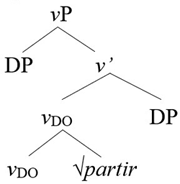
In contrast, the structure in (37) is not acceptable with the Chinese root √sui ‘break’. As presented earlier in Section 3.2, due to its semantic meanings, this Chinese root is compatible with vBECOME, vBE, or a, but not with vDO. The causative counterpart of ‘to break’ would require a causative derivational process in Chinese to form CR V-Vs. Before presenting the derivation of CR V-Vs, we will first discuss the zero causatives.
Chinese zero causatives are mainly derived from adjectives, nouns, or intransitive verbs, as shown in (22) for Modern Chinese and (19)–(21) for Old Chinese in Section 2.3. In these cases, the non-causative member takes a basic form, and the causative counterpart (i.e., the zero causative) is derived via a causative process. Inspired by Pylkkänen’s (2002) “root-selecting CAUSE” for lexical causatives, we hypothesize that Chinese zero causatives such as the causative use of 活跃huoyue ‘dynamic’ in (22b) involve a causative structure headed by vCAUSE, which takes a root as its Complement, as illustrated in (38a). A root that is directly selected by vCAUSE is restricted to be agentive (see Pylkkänen, 2002), and for this reason, Chinese zero causatives do not allow unergative roots, as shown by the ungrammaticality of (39). In general, the root directly selected by vCAUSE can be stative or eventive; when being eventive, it should have unaccusative but not agentive features. The non-causative use of these roots may involve a vBECOME, a vBE, or an a. A simplified representation is presented in (38b).
- (38)
- (a)
- (b)
- (39)
- *老师
- *Laoshi
- teacher
- 跳
- tiao
- jump
- 了
- le
- ASP
- 学生。
- xuesheng.
- student
- Intended: ‘The teacher made the student jump.’
In Chinese zero causatives, the vCAUSE head that the root is merged with is null. If the head vCAUSE is phonetically realized, the structure would correspond to morphological causatives such as (10) in Section 2.2, which were very common in Old Chinese but underwent a fade-away during language development.
Contrastingly, this zero causative process (i.e., causativization through a null causative marker) is either disallowed or very marginal in Portuguese, as illustrated in (40)–(41).
- (40)
- (a)
- O
- the
- anel
- ring
- caiu
- fell
- no
- on.the
- chão.
- ground
- ‘The ring fell on the ground.’
- (b)
- *O
- the
- João
- John
- caiu
- fell
- o
- the
- anel.
- ring
- ‘John made the ring fall.’
- (41)
- (a)
- Baixa
- downtown
- de
- of
- Coimbra
- Coimbra
- periga
- at-risk
- devido
- due
- a
- to
- produtos
- products
- inflamáveis.
- inflammable
- ‘The Coimbra downtown is at risk due to inflammable products.’
- (b)
- ??Produtos
- products
- inflamáveis
- inflammable
- perigam
- at-risk
- Baixa
- downtown
- de Coimbra
- of Coimbra
- (Diário Popular, June 25, 1986, p. 11)
- ‘Inflammable products make Coimbra downtown at risk.’
- (Peres & Móia, 1995, p. 197)
The Chinese CR V-Vs differ from zero causatives in that they contain not only the result-denoting root but also a cause-denoting one. Assuming with the Manner Incorporation/Conflation process in Harley (2005) and Haugen (2009), we hypothesize that while the result-denoting root (represented by √2) incorporates into vCAUSE and gets causativized, the cause-denoting root (represented by √1) conflates with vCAUSE as an adjunct, as illustrated in (42).15
- (42)
There are quite a few arguments in favor of our proposal. First, since the two roots are incorporated/conflated to the same head, the V-V adjacency is naturally yielded. Moreover, despite being syntactically formed, each CR V-V functions as one V0, in a way similar to how dance (v.) in (31a) is generated. Under the assumption that the categorizing head little v also functions as a phase head (see Marantz, 2007), after the completion of the merge of the roots into the little v, any further operation would have no access to the individual root but only the derived constituent headed by v. This can explain the compound properties of CR V-Vs. As shown in (43), neither V1 nor V2 is extractable via wh-movement. The restriction of a CR V-V being intervened by an aspect marker or an adverbial modifier (see Section 2.4) can also be explained.
- (43)
- (a)
- 他
- Ta
- he
- 唱
- chang
- sing
- 哭
- ku
- cry
- 孩子们
- haizimen
- children
- 了。16
- le.
- ASP
- ‘He made the children cry by singing.’
- (b)
- *他
- *Ta
- he
- 怎么
- zenme
- how
- 哭
- ku
- cry
- 孩子们
- haizimen
- children
- 了?
- le?
- ASP
- ‘How did he make the children cry?’
In addition, since vCAUSE directly selects a root in the CR V-V structure, the universal restriction of the embedded root being agentive (as in zero causatives) is also applied. As a result, the semantic constraint on V2 in CR V-Vs (see Section 2.4) can find an explanation. Being directly selected by vCAUSE, this root can be unaccusative but not unergative.
Moreover, as mentioned earlier in Section 2.4, while the morphological and zero causatives underwent a decrease in the Chinese language history, the CR V-Vs rose as alternative forms to express the causation of change of state.17 It has been suggested that the rise of CR V-Vs was driven by a disyllabification tendency that occurred during Chinese language development (see Shi, 2002; Xu, 2006). Due to this tendency, two monosyllabic roots adjoined each other to form a unit to express caused-result meanings, forming CR V-Vs. This diachronic change can be well illustrated syntactically with our account. Comparing the zero/morphological causative structure in (38a) and the CR V-V structure in (42), we find that the difference resides in the absence/occurrence of the cause-denoting root via Manner Conflation. We thus hypothesize that the disyllabification tendency in Chinese impacted the expressions of causation of change of state syntactically by obligating the Manner Conflation, as illustrated in (44). We further hypothesize that this historical change probably has led to the verbs’ division of labor that is observed in present-day Chinese: with the rise of CR V-Vs, the verb roots that frequently occur in the V1 position gradually came to express a pure activity, and those that frequently occur in the V2 position came to denote a (change of) state without causation.
- (44)
- Historical change motivated by disyllabification
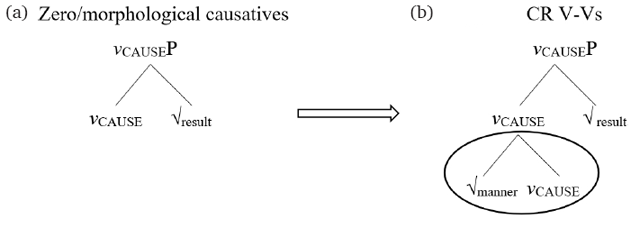
Since CR V-Vs exhibit both lexical and syntactic properties, some authors assume that they are generated in the lexicon (e.g., Thompson, 1973; Li, 1990, 1995; Cheng & Huang, 1994; Li, 2007) while others hold that they are syntactic structures (e.g., Lu, 1977; Huang, 1984, 1992; Gao, 1997; Sybesma, 1999; Basciano, 2010; Fan, 2013; Lin, 2004; Liu, 2019). In some works, they have also been analyzed as serial verbs (e.g., Nishiyama, 1998; Yang, 2013; Fan, 2016). The advantage of our account is that it can account for both the lexical properties and the productivity of Chinese CR V-Vs (since they are syntactically generated compounds).
Furthermore, attempts have been made to account for the argument structures of CR V-Vs (e.g., Li, 1990, 1995; Her, 2007), but it is still difficult to explain how semantic ambiguity can be produced with a particular CR V-V (see Section 2.4). With our account, the semantic ambiguity of CR V-Vs can also find an explanation, and readers can refer to Yao (forthcoming) for a detailed analysis.
To sum up, in expressing the causation of change of state, Portuguese may not employ any causative process because many verb roots are semantically complex and can produce causative meanings when turning into verbs via merge with vDO. Contrastingly, due to Chinese roots’ semantic simplicity, i.e., they denote a pure action or a (change of) state without causation, a causative construction is usually employed in expressing causation of change of state, as zero causatives or CR V-Vs.18
3.3.2. The non-causative
In the previous section, we have claimed that many Portuguese roots are intrinsically causative when turned into verbs by merging with vDO. That is the case with the Portuguese alternating verbs such as partir ‘to break’, as in (37), here repeated as (45a). To produce non-causative (inchoative) meanings, an anticausative process would be needed, as evidenced by the occurrence of the unaccusative clitic -se (although sometimes the anticausative marker may be null, see Section 2.3). Assuming that the anticausative marker is generated at Voice (see Alexiadou, Anagnostopoulou & Schäfer, 2006), we suggest that the anticausative use of partir ‘to break’ has the syntactic structure in (45b).
- (45)
- (a)
- (b)
For Portuguese verbs that express caused-result meanings and can form participles (see Section 2.5), an anticausative process is also evident since the non-causative members, namely the participles (e.g., avariado ‘damaged’), are derived from the causative counterparts (e.g., avariar ‘to damage’). As illustrated in (46), the verb avariar ‘to damage’ is generated via the merge of the root √avariar and the head vDO (46a), and the participle is further derived via an adjectivizing projection over vP (46b).
- (46)
- (a)
- (b)
That contrasts to Chinese, where the non-causative meaning ‘(get) damaged’ takes a basic form (47b), and the causative counterpart ‘to damage’ is derived via a causative process (47a) (see the CR V-V derivation process in Section 3.3.1 above).
- (47)
- (a)
- (b)
The difference between (46b) and (47b) roughly corresponds to Embick’s (2004) distinction between “stative” adjectives and “resultative” adjectives, where the “stative” type refers to adjectives in simple forms, and the “resultative” type refers to those in derived forms. We can find many cases where a stative meaning is expressed by a stative adjective in Chinese (a root merged with the a head) but a resultative form in Portuguese (i.e., participles). Besides the meaning ‘damaged’ presented above, such cases also include ‘tired’, ‘inclined’, ‘closed’, ‘wet’, ‘excited’, and ‘broken’, where the Chinese adjectives have simple forms but the Portuguese counterparts appear in derived forms.
Considering the discussions in this section and in Section 3.3.1, we can summarize the comparison of Chinese and Portuguese in expressing change-of-state events in Table 2.
Comparison on causation of change of state.
| Causative | Non-causative | |
| Portuguese | [vDO √] | [Voice [vDO √]], [a [vDO √]] |
| Chinese | [[√ vCAUSE] √], syntactic causative | [v/a √] |
We claim that the fundamental differences exist in the available semantics of the roots, as already discussed in Section 3.2. According to Beavers et al. (2017), there are two types of roots that form the basis of change of state events: one is essentially Dixon’s (1982) “property concept roots” or Levin’s (1993) “deadjectival change-of-state verbs”, denoting “concepts related to dimension, age, color, value, etc.”; the other type is “result roots”, which is basically Levin’s non-deadjectival change-of-state verbs, having to do with “physical damage, cooking, killing, etc.” (2017, p. 2).19 Following this distinction, we can infer that when expressing change-of-state events, Chinese expressions are often formed with “property concept roots”, which can derive simple statives and can further undergo a causative process to derive causative counterparts. In contrast, Portuguese expressions are often formed with “result roots”, which intrinsically express causative meanings and can further undergo an anticausative process to form non-causative counterparts.
3.3.3. Equipollent alternation
What about Portuguese verb-adjective pairs such as sujar ‘to stain’ – sujo/a ‘dirty’, where both members seem to be derived directly by the merge of the root and a head? I hypothesize that they belong to the “equipollent alternation” category (terminology from Haspelmath, 1993). They are derived from the same root merged with different functional heads: while the verb sujar ‘to stain’ involves a v head (48a), the adjective sujo/a ‘dirty’ involves an a head (48b). They are derived independently, and no causative or anticausative process is applied. In particular, the causative meaning of sujar ‘to stain’ is not produced by any causative marker (either being null or phonetically realized) but is driven by the joint force of the v head (should be a vDO in this case) and the encyclopedic meaning of the root. In other words, the suffix -ar is not a causative marker (as presented in Section 2.2, not all verbs with this suffix convey causative meanings). The same applies to limpar ‘to clean’ – limpo/a ‘clean’ and branquear ‘to whiten’ – branco/a ‘white’, where the causative and non-causative members are derived independently, although from the same root.
- (48)
- (a)
- (b)
The few Chinese simplex verbs that allow causative alternation, such as 开kai ‘to open’, may denote a pure activity, a (change of) state, or the causation of change of state. We hypothesize that the semantic meaning of the root makes it compatible with vDO, vBECOME, and a, as shown in (49). In our view, that also represents a case of equipollent alternation. However, readers may refer to Levin and Rappaport Hovav (1995), Ramchand (2008), among others, for alternative accounts of the causative alternation observed cross-linguistically.
- (49)
- [vDO √kai]:
- [vBECOME √kai]:
- [a √kai]
- [DO open (x, y)]
- [DO open (x, y)] CAUSE [BECOME open (y)]
- [BECOME open (y)]
- [BE open (y)]
3.4. Summary
The observed differences in expressing change-of-state events between Portuguese and Chinese are mainly due to the available semantics of the roots. Portuguese exhibits many result roots, which are intrinsically complex in semantics and can produce causative meanings when turned into verbs. However, these meanings may have to be expressed by complex forms in Chinese (e.g., CR V-Vs or syntactic causatives) because such result roots are not available. There are some apparent result roots such as √sha ‘kill’, but in fact, the result meaning is not necessarily implied. In general, Chinese verb roots tend to express a pure activity or a (change of) state without causation. On the other hand, while Chinese exhibits plenty of simple stative forms, they may correspond to complex forms in Portuguese, namely the deverbal adjectives or participles, because such property concept roots are not available in Portuguese.
Therefore, comparing the causative and non-causative expressions of change-of-state events, we observe opposite derivational directions in the two languages, as illustrated in Figure 1. Portuguese verbs can express complex meanings (i.e., caused-result meanings) and may undergo an anticausative process to derive non-causative counterparts. In contrast, Chinese verbs primarily denote simplex meanings, either a pure activity or a pure (change of) state. A causative process would be employed to produce causative meanings.
However, we are not claiming that this general trend applies to every change-of-state event. Both Portuguese and Chinese exhibit syntactic causatives (see Section 2.1), which clearly involve causative processes; moreover, the equipollent alternation is attested in both languages.
4. Conclusion
This study compares how causation is expressed in Portuguese and Chinese. The causation of activity is expressed by syntactic causatives in both languages. However, quite significant differences have been observed in the causation of change of state. In many cases, single verbs can express caused-result events in Portuguese, but such events are often expressed by complex forms in Chinese (i.e., syntactic causatives or CR V-Vs, see Appendix). The main reason resides in the semantic depository of the verb roots: while Portuguese exhibits result roots that can produce causative meanings intrinsically, Chinese roots primarily denote either a pure activity or a pure (change of) state.
Regarding the causative and non-causative pairs, we have observed that in Portuguese, the causative meanings can be expressed by simple forms (a root merged with v), while the non-causative counterparts (intransitives or participles) may be derived via an anticausative process (at Voice or a over vP). On the contrary, in Chinese, the non-causative meanings are often expressed by simple forms (a root merged with v/a), and the causative counterparts are derived via a causative process (e.g., CR V-Vs are formed via vCAUSE and Manner Conflation). That is to say, in expressing events of change of state, Portuguese and Chinese often exhibit opposite derivational directions (exceptions: syntactic causatives and equipollent alternation are attested in both languages).
To the best of my knowledge, there has not been much work on Romance-Chinese causative comparison in the literature. This study focuses on how Portuguese and Chinese differ, but the results may also apply to other Romance languages, and the data may contribute to the study of language variation and typology in causatives.
Another contribution of this study is that it attributes cross-linguistic differences in syntax (in this case, causatives) to the availability of root semantics. When accounting for language variation in syntax, a straightforward way is to claim that a particular syntactic structure exists in one language but not in another. Then the question is: why? The fundamental differences might originate from the roots. Suppose a particular semantic meaning is available in the roots of a language but not in another. In that case, it is probable that a more complex syntactic structure would be employed in the latter but may not even exist in the former one. Eventually, the syntactic variation we observe cross-linguistically may not be fundamentally syntactic.
More issues may be considered in future studies. For example, for Portuguese verbs such as purificar ‘to purify’ (corresponding to puro/a ‘pure’), which involve a base root and an apparent causative morpheme, does the v head have a CAUSE feature? Should -ificar be considered a phonetic realization of the head vCAUSE? Furthermore, the observations in this study may be taken as a preliminary theoretical foundation for future studies on translation and language acquisition.
Appendix
| Portuguese | Chinese |
| interessar ‘to interest’ |
|
| cansar ‘to tire, to make tired’ |
|
| irritar ‘to irritate’ |
|
| partir ‘to break’ |
|
| derreter ‘to melt’ |
|
| limpar ‘to clean’ |
|
| avariar ‘to damage’ |
|
| quebrar ‘to crack, to break’ |
|
| sujar ‘to stain’ |
|
| matar ‘to kill’ |
|
| cortar ‘to cut’ |
|
| rasgar ‘to tear’ |
|
-
1In current use, this compound expresses the meaning ‘to disgrace’. The meaning of ‘to stain’ or ‘to make dirty’ is mainly expressed by the CR V-V instances.
2We only present one CR V-V example here, because this is the one corresponding to the Portuguese verb matar ‘to kill’. However, other verbs may also occur in the V1 position, yielding a non-exhaustive list of combinations, such as 弄死nong si ‘make die’, 踹死chuai si ‘kick die’, 打死da si ‘beat die’ and 淹死yan si ‘sink die’.
3The simplex verb 切qie, although translated as ‘to cut’, only denotes the action of ‘cutting’ but does not necessarily imply the result meaning of ‘something in pieces’.
4The simplex verb 撕si, although translated as ‘to tear’, only involves the action meaning but not the result meaning of ‘something in pieces’.
Notes
- Abbreviations used in (1): COMP for complementizer, IMPERF for imperfective, SUBJ for subjunctive, PL for plural, INFL for inflected, and INF for infinitive. [^]
- The abbreviation CLF refers to classifiers. [^]
- The three different romanizations show the diachronic evolution of the word’s pronunciation. The one on the right end is Pinyin, which is based on the pronunciation of the Beijing dialect of Mandarin Chinese. [^]
- The first part of the terminology, causative-resultative, indicates the semantic meaning of this construction, and the second part, V-V, describes the surface form – two Vs are in adjacency. However, the term “V” applied here has a broader sense than the traditionally defined category of verbs – adjectives will also be included. In Chinese, there is not a clear line between verbs and adjectives because there is no morphological system to distinguish word classes, and Chinese adjectives can directly function as predicates, just like what verbs do. Oftentimes, the same formative in Chinese could function as a verb or an adjective in different syntactic contexts. The functional category of a formative may be tested out by means of reduplication or adverbial modifiers, but neither way is workable for CR V-Vs due to the syntactic restrictions of this construction (neither V1 nor V2 is allowed to reduplicate or take its own adverbial modifiers). In this study, our notion of “V” includes both verbs and adjectives, leaving the distinction between the two categories a separate issue. [^]
- 搞gao is another verb with the meaning of ‘do, make’ that may occur in the V1 position of CR V-Vs. In our study, 弄nong and 搞gao are treated as full verbs and thus can adjoion to vCAUSE as manner roots (see Section 3.3.1). For a different opinion, readers may refer to studies such as Basciano (2010), where 弄nong and 搞gao are treated as light verbs. [^]
- Note that if we put 了le (the aspect marker) in a position immediately following the verb, the result meaning is produced:
There have been hypotheses stating that when 了le immediately follows a verb, it functions as a resultative predicate with the meaning of ‘completion’, instead of an aspect marker. Readers may refer to Sybesma (1997) for detailed discussions. We do not include V-le into CR V-Vs but rather treat them as phase V-Vs, another type of verb compound. [^]
- 他
- Ta
- he
- 杀
- sha
- kill
- 了
- le
- ASP
- 那个
- na-ge
- that
- 女孩
- nvhai
- girl
- (了),
- (le),
- (ASP)
- (# 但是
- (# danshi
- (# but
- 她
- ta
- she
- 没
- mei
- not
- 死)。
- si).
- die)
- ‘He killed that girl, (# but she did not die).’
- The abbreviation CL refers to clitics. [^]
- Mencius is a collection of anecdotes and conversations of the Confucian philosopher Mencius. [^]
- Zuozhuan, generally translated as The Zuo Tradition or The Commentary of Zuo, is an ancient Chinese narrative history. [^]
- Analects is a collection of sayings and ideas from the philosopher Confucius and his contemporaries. [^]
- Here we say “simplex”, in opposition to the complex verbs, which are lexicalized verb compounds. [^]
- Other combinations are also possible. For example, 烧shao has the meaning ‘to burn, to heat’ and may serve as V1; 开kai ‘open’ can also express the meaning of ‘being boiled/boiling’ and may serve as V2. In fact, the combination shao-kai is preferred in oral speech, whereas zhu-fei in (29b) is used more in formal or literacy context. [^]
- Note that other combinations are also possible, such as da kai ‘hit-open’, nong kai ‘make open’ and ti kai ‘kick open’. [^]
- 碎sui can also function as an adjective with the meaning of ‘broken’. [^]
- Harley (2005) proposed that instrumental denominal verbs, such as hammer, involve Manner Incorporation applying to the little v, which takes a complement headed by an event-denoting root, as shown in the structure of Sue hammered the metal:
This was fine-grained by Haugen (2009), who distinguished between Incorporation and Conflation and claims that instrumental denominal verbs such as hammer involve Manner Conflation (instead of Incorporation). Other verbs of this type include brush, paddle, string, whistle, saw, anchor, and comb in verb use. Haugen’s proposal of Manner Conflation was later applied by Mateu (2012) for resultative sentences such as The boy danced his feet sore. [^]
- We have mentioned earlier that the V2 in CR V-Vs cannot be agentive. The Chinese verb 哭ku ‘cry’ can occur at V2 position here because this verb also has an unaccusative use. In addition, the verb 笑xiao ‘laugh’ also has an unaccusative use and can serve as V2 in CR V-Vs. As illustrated below, these two verbs can take an unaccusative marker 给gei:
[^]
- 听
- Ting
- listen
- 着
- zhe
- ASP
- 那
- na
- that
- 首
- shou
- CLF
- 歌,
- ge,
- song,
- 他
- ta
- he
- 给
- gei
- UNAC
- 笑/哭
- xiao/ku
- laugh/cry
- 了。
- le.
- ASP
- ‘Listening to that song, he laughed/cried.’
- Or, the decline of morphological and lexical causatives might be accelerated by the rise of CR V-Vs. [^]
- However, syntactic causatives are also available. [^]
- According to Beavers et al. (2017), “property concept roots” and “result roots” exhibit morphological and semantic differences cross-linguistically. For example, the property concept roots but not the result roots tend to have simple state forms (though exceptions exist), while result roots but not property concept roots entail change-of-state meanings even in templates lacking vBECOME. [^]
Acknowledgements
I would like to thank Anabela Gonçalves and Nélia Alexandre for their comments at the initial stage of this article’s preparation. An earlier version of this article was presented at XXXVI Encontro Nacional da Associação Portuguesa de Linguística, and I would like to thank the conference organizers for giving me the opportunity to present my work. All remaining errors are mine.
Competing Interests
The author has no competing interests to declare.
References
Alexiadou, A., Anagnostopoulou, E., & Schäfer, F. (2006). The Properties of Anticausatives Crosslinguistically. In M. Frascarelli (Ed.), Phases of Interpretation (pp. 187–211). Berlin: Mouton de Gruyter. DOI: http://doi.org/10.1515/9783110197723.4.187
Barbosa, P., & Raposo, E. (2013). Subordinação argumental infinitiva [Infinitive argumental subordination]. In E. Raposo, M. F. Nascimento, M. A. Mota, L. Segura & A. Mendes (Eds.), Gramática do Português [Portuguese grammar], Vol. 2 (pp. 1901–1977). Lisbon: Fundação Galouste Gulbenkian.
Basciano, B. (2010). Verbal compounding and causativity in Mandarin Chinese. PhD Thesis, Università degli Studi di Verona.
Beavers, J., Everdell, M., Jerro, K., Kauhanen, H., Koontz-Garboden, A., LeBovidge, E., & Nichols, S. (2017). Two types of states: A cross-linguistic study of change-of-state verb roots. Proceedings of the Linguistic Society of America, 2(38), 1–15. DOI: http://doi.org/10.3765/plsa.v2i0.4094
Cheng, L. L.-S., & Huang, C.-T. J. (1994). On the argument structure of resultative compounds. In M. Y. Chen & O. J.-.L. Tzeng (Eds.), In Honour of William S-Y. Wang: Interdisciplinary Studies on Language and Language Change (pp. 187–221). Taipei: Pyramid Press.
Comrie, B. (1976). The syntax of causative constructions: Cross-language similarities and divergences. In M. Shibatani (Ed.), The Grammar of Causative Constructions (pp. 261–312). New York: Academic Press.
Comrie, B. (1989[1981]). Language Universals and Linguistic Typology: Syntax and Morphology (2nd ed.). Chicago: University of Chicago Press.
Dixon, R. M. W. (1982). Where Have All the Adjectives Gone? The Hague: Mouton. DOI: http://doi.org/10.1515/9783110822939
Duarte, I., & Oliveira, F. (2010). Particípios resultativos [Resultative participles]. In A. M. Brito et alli (Eds.), Textos Seleccionados do XXV Encontro Nacional da Associação Portuguesa de Linguística (pp. 397–408). Lisbon: Colibri.
Embick, D. (2004). On the structure of resultative participles in English. Linguistic Inquiry, 35, 355–392. DOI: http://doi.org/10.1162/0024389041402634
Falk, Y. N. (1991). Causativization. Journal of Linguistics, 27(1), 55–79. DOI: http://doi.org/10.1017/S002222670001241X
Fan, S.-Y. (2013). Argument Structure in Mandarin Chinese: A Lexical-Syntactic Perspective. PhD thesis, Universidad Autónoma de Madrid.
Fan, Y. (2016). Serial Verb Constructions in Mandarin Chinese and Jinjiang Southern Min. PhD thesis, The University of Manchester.
Folli, R., & Harley, H. (2005). Consuming results in Italian and English: flavors of v. In P. Kempchinsky & R. Slabakova (Eds.), Aspectual Inquiries (pp. 95–120). Dordrecht: Springer. DOI: http://doi.org/10.1007/1-4020-3033-9_5
Folli, R., & Harley, H. (2007). Causation, obligation, and argument structure: On the nature of little v. Linguistic Inquiry, 38, 197–238. DOI: http://doi.org/10.1162/ling.2007.38.2.197
Gao, Q. (1997). Resultative verb compounds and BA-construction in Chinese. Journal of Chinese Linguistics, 25(1), 84–130. http://www.jstor.org/stable/23753982
Gonçalves, A. (1999a). Predicados Complexos Verbais em Contextos de Infinitivo não preposicionado do Português Europeu [Verbal complex predicates in contexts of non-prepositional infinitives in European Portuguese], Unpublished PhD thesis, University of Lisbon. DOI: http://doi.org/10.13140/RG.2.2.17732.45449
Gonçalves, A. (1999b). Minimizando a estrutura sintáctica dos complementos infinitivos nas construções com predicados complexos verbais do Português europeu [Minimizing the syntactic structure of infinitive complements in the constructions with verbal complex predicates in European Portuguese]. In A. C. Macário Lopes & C. Martins (Eds.), Actas do XIV Encontro da Associação Portuguesa de Linguística (pp. 569–586). Braga: Gráfica de Coimbra.
Halle, M., & Marantz, A. (1993). Distributed Morphology and the pieces of inflection. In K. Hale & S. Keyser (Eds.), The View from Building 20 (pp. 111–176). Cambridge, MA: The MIT Press.
Halle, M., & Marantz, A. (1994). Some key features of Distributed Morphology. MIT Working papers in Linguistics, 21, 275–288.
Harley, H. (2005). How do verbs get their names? Denominal verbs, manner incorporation and the ontology of verb roots in English. In N. Erteschik-Shir & T. Rapoport (Eds.), The Syntax of Aspect. Deriving Thematic and Aspectual Interpretation (pp. 42–64). Oxford: Oxford University Press. DOI: http://doi.org/10.1093/acprof:oso/9780199280445.003.0003
Haspelmath, M. (1993). More on the typology of inchoative/causative verb alternations. In B. Comrie & M. Polinsky (Eds.), Causatives and Transitivity (pp. 87–121). Amsterdam: John Benjamins. DOI: http://doi.org/10.1075/slcs.23.05has
Haugen, J. D. (2009). Hyponymous Objects and Late Insertion. Lingua, 119, 242–262. DOI: http://doi.org/10.1016/j.lingua.2007.10.008
Her, O.-S. (2007). Argument-function mismatches in Mandarin Resultatives: A lexical mapping account. Lingua, 117, 221–246. DOI: http://doi.org/10.1016/j.lingua.2006.01.002
Huang, C.-T. J. (1984). Phrase structure, lexical integrity and Chinese compounds. Journal of Chinese Language Teachers Association, 19(2), 53–78.
Huang, C.-T. J. (1992). Complex predicates in control. In R. Larson, S. Latridou, U. Lahiri & J. Higginbotham (Eds.), Control and Grammar (pp. 109–147). Dordrecht: Kluwer Academic Publishers. DOI: http://doi.org/10.1007/978-94-015-7959-9_4
Huang, C.-T. J. (2006). Resultatives and unaccusatives: a parametric view. Bulletin of the Chinese Linguistic Society of Japan, 253, 1–43. DOI: http://doi.org/10.7131/chuugokugogaku.2006.1
Huang, S. (1974). Mandarin causatives. Journal of Chinese Linguistics, 2(3), 354–369.
Kulikov, L. I. (2001). Causatives. In M. Haspelmath, E. Konig, W. Oesterreicher, W. Raible & Z. Teilbande (Eds.), Language Typology and Language Universals Vol. 2, (pp. 886–898). Berlin and New York: Walter de Gruyter.
Levin, B. (1993). English Verb Classes and Alternations. Chicago, IL: University of Chicago Press.
Levin, B., & Rappaport Hovav, M. (1995). Unaccusativity: At the Syntax-Lexical Semantics Interface. Cambridge, MA.: MIT Press.
Li, C. (2007). Mandarin Resultative Verb Compounds: Where Syntax, Semantics, and Pragmatics Meet. PhD thesis, Yale University.
Li, Y. (1990). On V-V compounds in Chinese. Natural Language and Linguistic Theory, 8(2), 177–207. http://www.jstor.org/stable/4047698. DOI: http://doi.org/10.1007/BF00208523
Li, Y. (1995). The thematic hierarchy and causativity. Natural Language and Linguistic Theory, 13(2), 255–282. http://www.jstor.org/stable/4047827. DOI: http://doi.org/10.1007/BF00992783
Lin, J. (2004). Event Structure and the Encoding of Arguments: The Syntax of the Mandarin and English Verb Phrase. PhD thesis, Massachusetts Institute of Technology. http://hdl.handle.net/1721.1/28710
Liu, J. (2019). The Syntax of VV Resultatives in Mandarin Chinese. PhD thesis, University of Victoria. http://hdl.handle.net/1828/10559
Lu, J. H.-T. (1977). Resultative verb compounds vs. directional verb compounds in Mandarin. Journal of Chinese Linguistics, 5(2), 276–313. http://www.jstor.org/stable/23753020
Marantz, A. (1997). No escape from syntax: Don’t try morphological analysis in the privacy of your own lexicon. University of Pennsylvania Working Papers in Linguistics, 4(2), 201–225.
Marantz, A. (2007). Phases and words. In S. Choe (Ed.), Phases in the Theory of Grammar (pp. 191–222). Seoul: Dong-In Publishing Co.
Mateu, J. (2012). Conflation and Incorporation Processes in Resultative Construction. In V. Demonte & L. McNally (Eds.), Telicity, Change, and State: A Cross-Categorial View of Event Structure (pp. 252–278). Oxford: Oxford University Press. DOI: http://doi.org/10.1093/acprof:oso/9780199693498.003.0010
Matos, G. (1999). Desvio e conhecimento linguístico em construções causativas do Português Europeu [Deviation and linguistic knowledge in causative constructions of European Portuguese]. In I. H. de Faria (Ed.), Lindley Cintra—Homenagem ao Homem e ao Cidadão (pp. 541–564). Lisbon: Edições Cosmos/Faculdade de Letras da Universidade de Lisboa.
Mei, T.-L. (2012). The causative *s- and nominalizing *-s in Old Chinese and related matters in Proto-Sino-Tibetan. Language and Linguistics, 13(1), 1–28.
Montrul, S. (2001). The Acquisition of Causative/Inchoative Verbs in L2 Turkish. Language Acquisition, 9(1), 1–58. DOI: http://doi.org/10.1207/S15327817LA0901_01
Nichols, J., Peterson, D. A., & Barnes, J. (2004). Transitivizing and detransitivizing languages. Linguistic Typology, 8(2), 149–211. DOI: http://doi.org/10.1515/lity.2004.005
Nishiyama, K. (1998). V-V compounds as serialization. Journal of East Asian Linguistics, 7, 175–217. DOI: http://doi.org/10.1023/A:1008265805417
Peres, J., & Móia, T. (1995). Áreas Críticas da Língua Portuguesa [Critical areas of Portuguese language]. Lisbon: Caminho.
Pylkkänen, L. (2002). Introducing arguments. PhD thesis, MIT.
Ramchand, G. (2008). Verb Meaning and the Lexicon: A First-Phase Syntax. Cambridge: Cambridge University Press. DOI: http://doi.org/10.1017/CBO9780511486319
Raposo, E. (1981). A Construção ‘União de Orações’ na Gramática do Português [The construction ‘sentence union’ in Portuguese grammar], Unpublished PhD thesis, University of Lisbon.
Santos, A. L., Gonçalves, A., & Hyams, N. (2016). Aspects of the acquisition of object control and ECM-type verbs in European Portuguese, Language Acquisition, 23(3), 199–233. DOI: http://doi.org/10.1080/10489223.2015.1067320
Shen, Y., & Huang, X. (2017). 现代汉语的新型使动结构和意动结构–兼谈汉语综合性句法类型的复苏Xiandai hanyu de xinxing shidong jiegou he yidong jiegou – jian tan hanyu zonghe xing jufa leixing de fusu [The new causative constructions in Modern Chinese – and the renaissance of synthetic constructions]. Yuejiang Academic Journal, 4, 20–32. DOI: http://doi.org/10.13878/j.cnki.yjxk.2017.04.002
Shi, Y. (2002). The Establishment of Modern Chinese Grammar: The Formation of the Resultative Construction and Its Effects. Amsterdam-Philadelphia: John Benjamins. DOI: http://doi.org/10.1075/slcs.59
Shibatani, M. (1976). The grammar of causative constructions: A conspectus. In M. Shibatani (Ed.), The Grammar of Causative Constructions (pp. 1–40). New York: Academic Press. DOI: http://doi.org/10.1163/9789004368842_002
Sybesma, R. (1997). Why Chinese verb-le is a resultative predicate. Journal of East Asian Linguistics, 6(3), 215–261. DOI: http://doi.org/10.1023/A:1008238319773
Sybesma, R. (1999). The Mandarin VP. Dordrecht: Kluwer Academic Publishers. DOI: http://doi.org/10.1007/978-94-015-9163-8
Tai, J. H.-Y. (1984). Verbs and Times in Chinese: Vendler’s four categories. In D. Testen, V. Mishra & J. Drogo (Eds.), Papers from the Parasession on Lexical Semantics (pp. 289–296). Chicago: Chicago Linguistic Society. DOI: http://doi.org/10.1002/asna.18780920506
Thompson, S. A. (1973). Resultative verb compounds in Mandarin Chinese: a case for lexical rules. Language, 49(2), 361–379. DOI: http://doi.org/10.2307/412459
Xu, D. (2006). Typological Change in Chinese Syntax. New York: Oxford University Press. DOI: http://doi.org/10.1093/acprof:oso/9780199297566.001.0001
Xu, T. (1998). 使动和自动——汉语语义句法的两种基本句式及其历史演变Shidong he zidong – hanyu yuyi jufade liang zhong jiben jushi ji qi lishi yanbian [Causatives and inchoatives – the two basic sentence patterns and their historical development]. Chinese Teaching in the World, 1, 12–22.
Yang, Y. (2013). Word order and constituency of Serial Verb Constructions. Lingua Posnaniensis, 55(1), 111–151. DOI: http://doi.org/10.2478/linpo-2013-0008
Yao, J. (forthcoming). On the semantic ambiguity of Chinese Causative Resultative V-Vs. Proceedings of the 22nd Chinese Lexical Semantic Workshop (CLSW2021).
